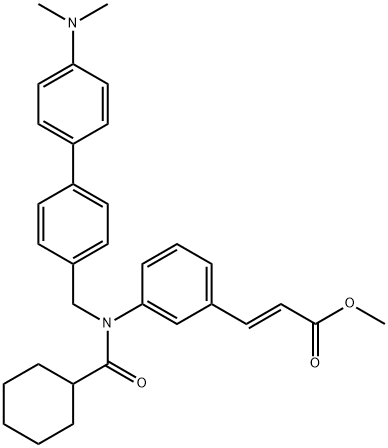The farnesoid X receptor (FXR) is a nuclear receptor that acts as a bile acid sensor, protecting cells and organs against bile acid toxicity and coordinating cholesterol metabolism, lipid homeostasis, and absorption of dietary fats and vitamins. Fexaramine is an FXR agonist (EC50 = 25 nM) that demonstrates 100-fold increased affinity to FXR compared to endogenous bile acids and 3-fold increased potency compared to the high affinity FXR agonist GW 4064 nesoid X receptor (FXR) is a nuclear receptor that acts as a bile acid sensor, protecting cells and organs against bile acid toxicity and coordinating cholesterol metabolism, lipid homeostasis, and absorption of dietary fats and vitamins. Fexaramine is an FXR agonist (EC50 = 25 nM) that demonstrates 100-fold increased affinity to FXR compared to endogenous bile acids and 3-fold increased potency compared to the high affinity FXR agonist GW 4064 nesoid X receptor (FXR) is a nuclear receptor that acts as a bile acid sensor, protecting cells and organs against bile acid toxicity and coordinating cholesterol metabolism, lipid homeostasis, and absorption of dietary fats and vitamins. Fexaramine is an FXR agonist (EC50 = 25 nM) that demonstrates 100-fold increased affinity to FXR compared to endogenous bile acids and 3-fold increased potency compared to the high affinity FXR agonist GW 4064 nesoid X receptor (FXR) is a nuclear receptor that acts as a bile acid sensor, protecting cells and organs against bile acid toxicity and coordinating cholesterol metabolism, lipid homeostasis, and absorption of dietary fats and vitamins. Fexaramine is an FXR agonist (EC50 = 25 nM) that demonstrates 100-fold increased affinity to FXR compared to endogenous bile acids and 3-fold increased potency compared to the high affinity FXR agonist GW 4064 nesoid X receptor (FXR) is a nuclear receptor that acts as a bile acid sensor, protecting cells and organs against bile acid toxicity and coordinating cholesterol metabolism, lipid homeostasis, and absorption of dietary fats and vitamins. Fexaramine is an FXR agonist (EC50 = 25 nM) that demonstrates 100-fold increased affinity to FXR compared to endogenous bile acids and 3-fold increased potency compared to the high affinity FXR agonist GW 4064 nesoid X receptor (FXR) is a nuclear receptor that acts as a bile acid sensor, protecting cells and organs against bile acid toxicity and coordinating cholesterol metabolism, lipid homeostasis, and absorption of dietary fats and vitamins. Fexaramine is an FXR agonist (EC50 = 25 nM) that demonstrates 100-fold increased affinity to FXR compared to endogenous bile acids and 3-fold increased potency compared to the high affinity FXR agonist GW 4064 nesoid X receptor (FXR) is a nuclear receptor that acts as a bile acid sensor, protecting cells and organs against bile acid toxicity and coordinating cholesterol metabolism, lipid homeostasis, and absorption of dietary fats and vitamins. Fexaramine is an FXR agonist (EC50 = 25 nM) that demonstrates 100-fold increased affinity to FXR compared to endogenous bile acids and 3-fold increased potency compared to the high affinity FXR agonist GW 4064 nesoid X receptor (FXR) is a nuclear receptor that acts as a bile acid sensor, protecting cells and organs against bile acid toxicity and coordinating cholesterol metabolism, lipid homeostasis, and absorption of dietary fats and vitamins. Fexaramine is an FXR agonist (EC50 = 25 nM) that demonstrates 100-fold increased affinity to FXR compared to endogenous bile acids and 3-fold increased potency compared to the high affinity FXR agonist GW 4064 nesoid X receptor (FXR) is a nuclear receptor that acts as a bile acid sensor, protecting cells and organs against bile acid toxicity and coordinating cholesterol metabolism, lipid homeostasis, and absorption of dietary fats and vitamins. Fexaramine is an FXR agonist (EC50 = 25 nM) that demonstrates 100-fold increased affinity to FXR compared to endogenous bile acids and 3-fold increased potency co

